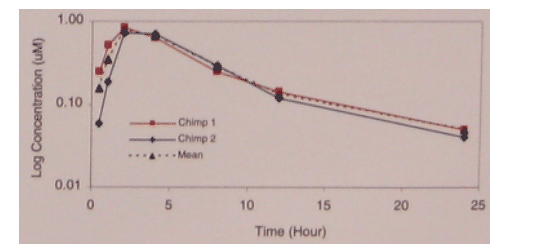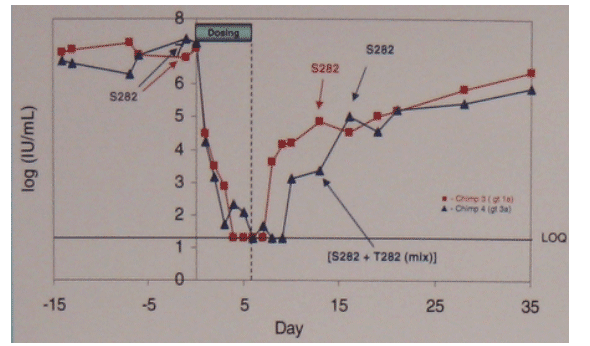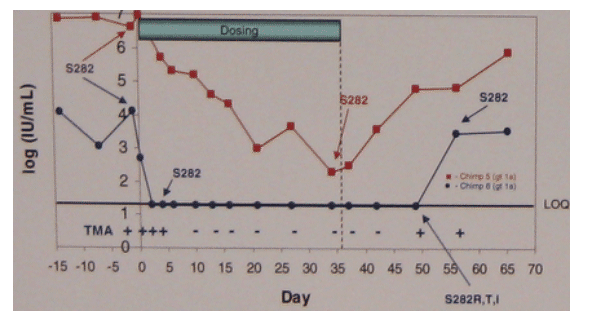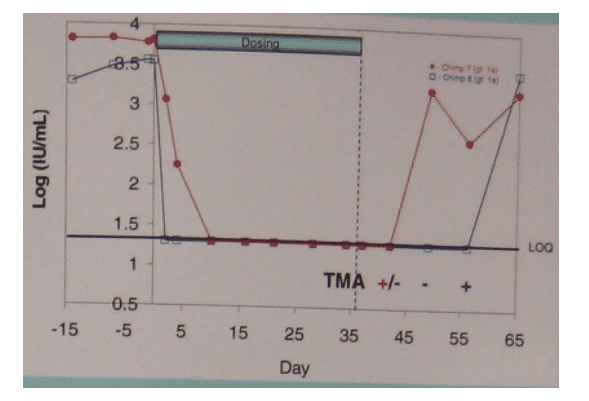 |
 |
 |
| |
Merck HCV Polymerase Inhibitor
|
| |
| |
"Robust Suppression of Viral Replication by a Nucleoside in Chimpanzees Infected with Hepatitis C Virus"
Steven Carroll et al. Merck
AASLD, Oct 27-31, 2006, Boston, MA
Purpose: to evaluate the antiviral efficacy of administration of a nucleoside polymerase inhibitor to hepatitis C virus (HCV) infected chimpanzees.
Background: Efforts to develop novel therapies to treat HCV infection that enhance both efficacy and tolerability over exiting therapies have focused on direct antiviral agents targeting the virally encoded RNA-dependent RNA polymerase , NS5B, and protease, NS3/4A. Previously, we have shown that 2'-C-methyl-7-deaza-adenosine, a nucleoside analog inhibitor of the NS5B RNA polymerase, potently inhibits HCV RNA replication in the bicistronic replicon assay with an EC50 of 0.3 uM.
Methods: The nucleoside analog was administered once daily to chronically infected chimpanzees by either oral or intravenous routes at different dose levels and for different durations. Periodically blood samples were withdrawn and plasma viral titers were determined using ther Versant bDNA (Bayer), HCV Taqman (Roche) or transcription-mediated amplification (Roche) assays.
Results: The nucleoside analog can profoundly suppress viral replication in chimps chronically infected with HCV. Once daily administration of the compound resulted in a rapid dose-dependent decrease in plasma viral RNA. After dosing for 7 days at 2 mg per kg once daily via intravenous administration, viral RNA levels in plasma decreased to levels below the limit of quantification of the Taqman assay, representing a >5 log decrease in plasma viremia. Oral administration at the same dose level for 37 days resulted in substantial decreases (>3 logs) in viral load and no rebound during dosing was evident.
Conclusions: The antiviral activity of the nucleoside analog in HCV-infected chimps is comparable to the efficacy observed with NS3 protease inhibitors in HCV-infected patients suggesting potent suppression of viral replication can be achieved and maintained throughout the duration of dosing in vivo with inhibitors of the HCV polymerase.
Background
--RNA polymerase IC50 (triposphate) = 0.07 uM
--replicon EC 50 (genotype 1b)= 0.3 uM
--infectious gt 2a virus EC50 about 0.2 uM
--well phosphorylated in cells
--not s substrate for adenosine deaminase
--viral resistance in cell culture is engendered by S282T mutation in the viral RNA polymerase, which results in a 30-fold loss of potency in the replicon assay.

For pharmacokinetic studies, unifected chimps were dosed orally & blood samples were withdrawn periodically over a 24 hour period while the animals were alert. Total nucleoside concentration was determined in the plasma samples using LC/MS. A total of 6 HCV-infected chimps were dosed either by oral administration while alert with compound as a solution in Tang or by intravenous administration under mild sedation with compound in sterile saline. Periodically blood samples were withdrawn for compound and viral load determination using the HCV Taqman (Roche, limit of detection (LOQ) of 20 IU/mL) or transcription-mediated amplification (TMA, Roche, LOD 10 IU/mL) assays. Viral sequences were rescued using RT-PCR from plasma samples collected at various time points throughout the study and population cDNA sequencing of the NS5B RNA polymerase gene was carried out.
RESULTS
1. PK in uninfected chimps after oral dosing of 1 mpk.

Figure 1. Compound (nucleoside) concentration in chimp plasma after oral dosing. Two uninfected chimps were dosed at 1 mpk. Plasma samples were collected at various time post-dosing and the concentration of the nucleoside was determined.
Plasma parameters (nucleoside)
AUC - 5.6 uM-hr
Cmax - 0.8 uM
Tmax - 2 hr
C24 - 0.05 uM
2. Effects on plasma viral load after IV administration at 2 mpk.

Figure 2. Plasma viral load in HCV-infected chimps dosed by IV administration.
Compound was administered at 2 mpk once daily for 7 days. Plasma viral loads were determined using the Rochw Taqman assay. The plasma concentration of the compound at about 10 min post-dose averaged 9.9 and 11.0 uM for chimps 3 and 4, respectively. The compound concentration at 24 h post each dose ranged from 80 nM after the first dose to about 200 nM after the fourth dose and did not increase thereafter. Viral loads decreased by <5 logs during dosing in both chimps.
3. Effects on plasma viral load after oral administration at 1 and 2 mpk.

Figure 3. Plasma viral load in HCV-infected (genotype 1a) chimps dosed by oral administration at 1 mpk.
Compound was administered once daily for 37 days. Plasma viral loads were determined using the Roche Taqman assay. Qualitative detection of viral load in the chimp that reached LOQ was carried out using the TMA assay. At the end of 37 days of dosing, plasma samples were collected 24 hrs after the last dose and the compound concentrations were determined to be 113 and 122 nM in chimps 5 and 6, respectively.

Figure 4. Plasma viral load in HCV-infected (genotype 1a) chimps dosed by oral administration at 2 mpk.
Compound was administered once daily for 37 days. Plasma viral loads were determined using the Roche Taqman assay. Aqualitative detection of viral load was carried out using the TMA assay. Viral loads remained below LOQ in the Taqman assay for at least 6 and 20 days after dosing ended. Red line is chimp 7, black line is chimp 6.
4. Analysis for viral resistance
Viral sequences were rescued from plasma samples for all chimps at several time points. In all cases virus encoded S282 of the NSB5 RNA polymerase prior to administration of the compound. Population sequencing revealed the presence of resistance mutations at S282 in 2 chimps at a time when viral loads started to rebound after dosing ended (Fig 2 and 3). Samples from later time points in all cases contained only S282, suggesting a replicative disadvantage to the virus encoding mutations at that position.
Conclusions
IV and oral dosing of 7-Deaza-2'-C-methyl-adenosine to HCV-infected chimps results in significant reductions in viral load.
-- >5 log reduction in viral load (2 mpk IV)
-- no rebound during dosing
-- delay in rebound after end of extended dosing
Resistant viral variants at S282 are detected after dosing ends as virus starts to rebound
-- variants not detected in samples from later time points.
|
| |
|
 |
 |
|
|